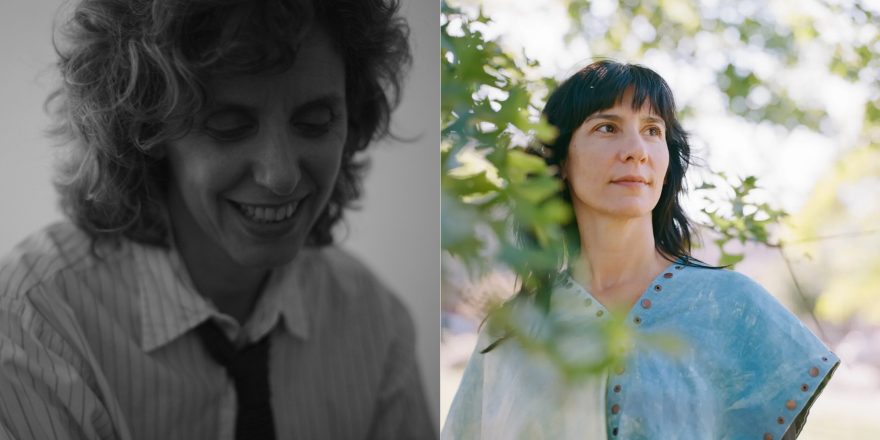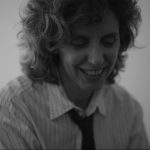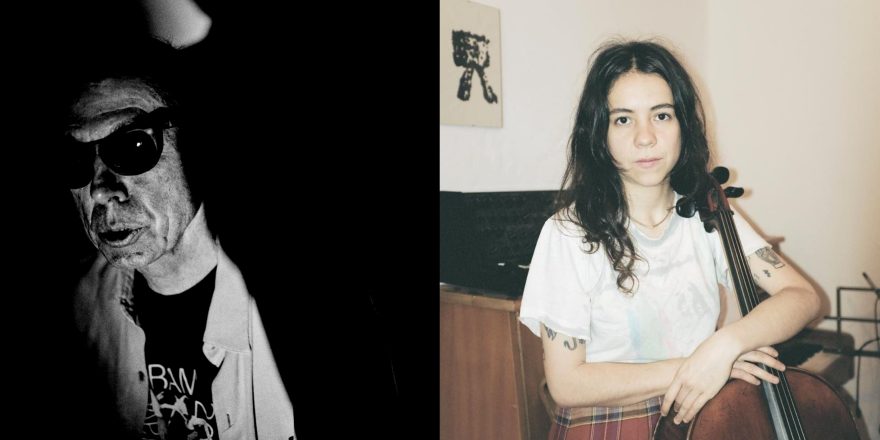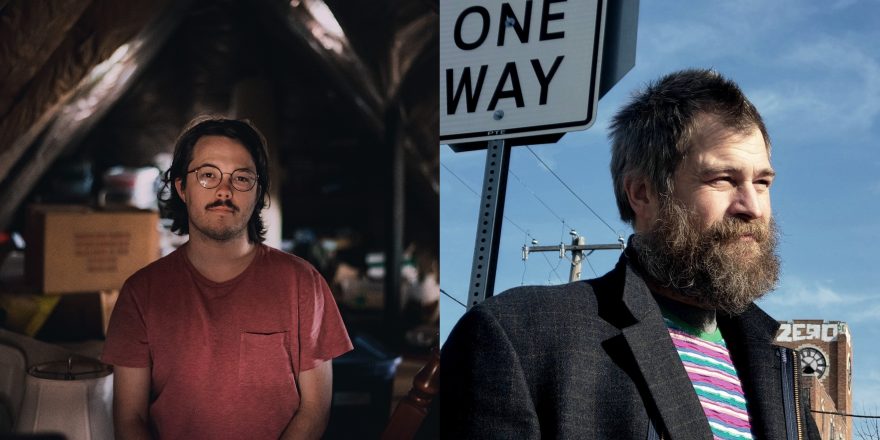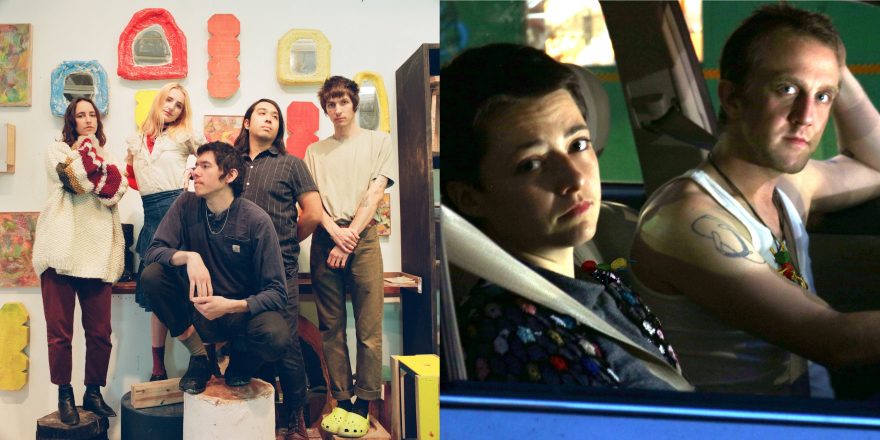Zeena Parkins is a New York-based harpist, electro-acoustic musician and composer; Jessica Pavone is a violinist and composer, also based in New York. Both are releasing records this year — Zeena’s LACE was just released on Chaikin Records, and Jessica’s Clamor will be out October 6 on Out of Your Head Records — so to celebrate, the two connected on Zoom to talk about their creative processes and much more.
— Annie Fell, Editor-in-chief, Talkhouse Music
Zeena Parkins: I wanted to thank you for your questions. It’s really great that you’re so organized. It kind of served to focus thoughts on just what topics might be good for us to talk about.
Jessica Pavone: Yeah. I realized as I was formulating the questions, most of them were based on wanting to understand your process. That’s something I’m interested in terms of composition, understanding my process and if people experience process in the same way. And I saw your questions — your questions were very elaborate. Way more sophisticated than my questions. [Laughs.]
Zeena: Oh, I don’t think so, actually. I mean, I was inspired by your questions. One thing I just want to start with: I was really fascinated that you were looking at a secret language [Nu Shu, a secret language developed by Chinese women forbidden from going to school]. I wrote a piece many years ago that was based on Rotwelsch, which was a thieves’ language, which was also a secret language. I was thinking about how marginalized or disenfranchised groups sort of figure out a way to circumvent lack of agency by creating these other worlds, other languages, other ways to create an economy. Which is partially what LACE is about. But I think that you would be interested in this piece with the idea of the secret language I found.
Jessica: What is the instrumentation for that piece?
Zeena: It was my gangster band, which I had in the early ‘90s. It was two cellos, but one of the cellos also played electric guitar — it was Mark Stewart, who’s now in Bang on a Can. But he plays homemade instruments — daxophone, electric guitar — so he was doing a bunch of different things, and voice. And then my sister Maggie on cello and voice, my sister Sara on violin, me on accordion and samples, keyboards. I was on keyboards, piano and accordion. That was the band. We did several projects and that was one of them [Mouth:Maul:Betrayer on Tzadik].
Jessica: Yeah. I mean, for me, the whole concept of the album came after I started working on it. One of the questions you had sent me was about research-based projects, and this is actually the first project I’ve ever done where there was this kind of research involved. And that wasn’t my intention when I started it. My intention when I started it was, I had gotten really interested in the idea of making these concertos for improvisers. I know you have a solo language — I have a solo language. I’m really interested in instrumentalists who have their own language on their instrument, who are more original with their instrument rather than stylists. So the first piece I did like that, I wrote these concertos for Brian Chase and Nate Wooley, who both have very distinct languages on their instruments. It was for a string octet and there were two violins, two violas, two cellos and two basses. And after I finished it, I realized I wanted to do another project like that.
I was thinking of what musician wanted to work with, and Katherine [Young] is an old friend of mine. We’ve done double solo tours together and I know her bassoon language really well, so I wanted to work with her. And because she’s playing bassoon and it’s the low end, I decided to get rid of one bass and one cello and work with this ensemble minus that low end. What ended up happening is it was an ensemble of all females. That was a total coincidence.
Zeena: That wasn’t the original intention?
Jessica: No, none of it was intended that way. The intention was, I want to write a concerto. I started writing the piece, and the first movement I wrote just felt like a seesaw — so I started researching the origins of the seesaw around the world, and I came across this standing seesaw Korean women invented so that they can look outside of the walls of their property [the Neolttwigi]. Married Korean women weren’t allowed to leave, so they invented the seesaw so they can look outside the walls and see what was going on in the city, or to see if their husbands were cheating on them, that kind of thing.
So from there, I got the idea, Oh, this would be really cool if all of the movements of this piece were named after inventions by women to circumvent obstructions to their freedom. And that’s where it came from. Then I started doing research, and I coincidentally came upon Nu Shu, which kind of made sense to be the piece that would be in dialogue with the soloist. It just kind of all coincidentally came together.
Zeena: So it’s like the piece found the topic rather than the topic found the piece.
Jessica: The piece found the topic. And doing research was difficult because I don’t really know how to do research anymore — because most of what we do is on the internet and you don’t know what to trust, you know? I was just, like, checking random books out of the library. I was talking about it all of the time to everybody I knew, just to see if someone [knew anything]. I just didn’t really know how to do research.
Zeena: But you figured it out.
Jessica: I figured it out.
Zeena: So the big idea is, you wanted to continue the idea of working with soloists that have distinct developed languages in the context of what you’re calling — and which, in fact, is — a kind of concerto. And then this project was the next version of that, and somehow the way the music went inspired finding the topic.
Jessica: Right, it never was never my intention. Something that’s incorporated in my writing process a lot is — you asked me a question about agency, and just talking about freedoms — I think a lot about notation and how there’s this notation that we all know and can read, but it’s very limiting. I’m always trying to work with ways to open up notation and to have everyone have a choice. There’s elements of indeterminacy in the piece.
Zeena: It sounds like you use the clock as a way to cordon off different moments and ways to delineate different kinds of playing, different combinations of players. In a way, traditional notation is like a clock too.
Jessica: Yeah.
Zeena: So what do you think you get from abandoning this more traditional way of communicating your ideas? In a way, your players are still on a grid, but where do you find the freedom within that?
Jessica: I feel like it depends on how I’m using it. But one specific example: I’ll have players alternating between pitches and a pitch set at their own chosen tempo. I’ll maybe give them a range like 30 and 60, and they’re all independent of one another. I find that when you let people zone out and do their own thing in this time frame, they kind of get more inside of the music. But also what happens when everyone’s independent and doing their own thing is you get these crazy polyrhythms sometimes — which I feel like if you notated it out, it would be stressful to play. Instead, they get to just enjoy feeling in the sound. So part of my intention is for the players to just enjoy what they’re doing and not be so stressed by counting. But then also, it’s what we like about improvisation — there’s an element of something you actually couldn’t create.
Zeena: Yeah. And also, it sounds like a kind of immersion in what an individual player is doing — this immersion in the sound is really particular with the way you’re organizing materials it seems. And how about the the kinds of information you gave Katherine as opposed to the information you gave the ensemble?
Jessica: Well, the way I approached that is I took a bunch of sounds of hers that I know she makes on her bassoon, and I created a notation that I think represents that.
Zeena: Oh, OK.
Jessica: Some of it is just little descriptions, and some of it is — I created a notation that sort of looks like what she’s doing, and then I literally just decide, what could the strings do to mimic this? Mostly I’m just trying to have the strings sort of mimic her, but in their own capabilities of instrument. It’s not totally graphic, it’s on a five line, but they’re graphic in a sense. I love to just mess with finale and see all the different things I can do that look untraditional.
Zeena: Right. OK, so you’re working specifically with a way of feeding back to her in these pictograms or this notation that you’re inventing.
Jessica: Yeah. It’s like using notation to try to write a texture. But I also don’t really work in graphic notation so much because I like to be as specific as possible. I want to have a general sense of what it’s going to sound like. I don’t want there to be too much openness. So I want it to resemble notation enough so that there can be a structure.
I’m curious about how you approach notation, because in the liner notes you were talking about an experience you had. It sounded like it was somewhere in Europe, and pages were flying everywhere, musicians were having a hard time recreating the music. And when you created the LACE score, you initially were in a time limit, which kind of informed what you were capable of doing, but it also kind of freed you from the other ways of writing. I was wondering if you had been experimenting with that for a while?
Zeena: No, it was really overdue for me to find a different way in to dealing with this kind of ensemble writing that I’d been doing. The pieces were really hard, and in some ways it was always a failure to play those pieces.
Jessica: Hard in the sense that they were rhythmically complicated?
Zeena: Well, yeah, they were rhythmically complicated. The kinds of pieces that if you had a month to rehearse every day, it would sound amazing.
Jessica: Why do you think you were writing in that way?
Zeena: Because that’s what I heard. I was trying to get to something and eventually I figured out that writing notation in that way was not necessarily the way to get to it. So it was a frustration and a kind of failure — of course, it wasn’t a complete failure because unexpected/unpredictable things always emerge but in trying to meet a tight deadline, I was forced to come up with something different. It was a quartet for a commission from the Merce Cunningham Studio. Here was an opportunity, I’ve gotta think of another way to do this because it’s a situation that won’t allow for the way I’ve been doing things previously.
I had already been engaged with fabrics. I lived in the Lower East Side in a moment when it still had a lot of those old fabric stores and notion stores, and I was living with a costume designer. I made my own clothes. I was very attracted to the idea of turning a flat thing into a three dimensional thing. So I had Stoff lying around — I had collected in Europe and in Japan. You know, who knows where these ideas come from…
Jessica: It’s all part of you. I think a lot of our other interests come into play.
Zeena: Yeah. It all just came together in a flash. I was always attracted to the more graphic or geometric patterns in these lace pieces rather than organic, like flowers and plants. So I took five different pieces that really had different levels of complexity, and glued them on a board and that was the piece. I gave the players what I called “conditions” for engaging with a way to look at those five different pieces. And it very much had to do not only with the individual piece but also the pieces in relation to each other. We worked on it for a couple hours and we performed it the next day and that was that. It was never intended to be a big project. It was just a piece. But I was really intrigued. It’s like when I made my electric harp — I just banged together with used components and it was quite basic, but I could tell right away that the idea was going to work. This was a similar kind of thing, like, Oh, there’s something to this.
I had the opportunity after that through the years to workshop it in various festivals in Europe, in Glasgow and Mulhouse and Porto. It just started taking on a life of its own. Then after a while, I was like, Well, why do I just have to put the lace flat exactly like it is on the page? Why can’t I manipulate it? And I came up with this idea of what I called action cards. These were changing the shape and messing with how it sits on the page, the lace itself — sometimes it’s all balled up, sometimes I would unravel it, sometimes I would turn it into a shape like an X or a circle. Those 26 cards were started with a completely different way of looking at the material. So it just began to unfold in this really organic way. And every time I would think, I’m done with this, I’ve done it enough, some other idea would emerge that I really wanted to investigate.
Jessica: Taking space from a project and reapproaching it over years is interesting to me, because sometimes you have a lot of insight when you’ve walked away from something and you come back to it. Either you’re a different person, or I feel like when you’re working on something, you’re too close to it or too inside of it to really see clearly. It’s great to be able to walk away and give it space. So I was curious how that evolved for you. It sounds like the cards was one of the ways.
Zeena: Yeah. I realized that so many of my compositional projects really go on for years. I get initial ideas or excited about one thing, and then I develop it, and then some of it works, some of it doesn’t. I perform it, maybe even record it, and then it gets put on the back burner. Then it re-emerges. If there’s something really to it that I figure I didn’t solve then I want to engage with it again if I can.
Jessica: Yeah, I think that’s a pretty amazing way to approach.
Zeena: So I’m not hung up on a definitive version necessarily.
Jessica: This record that just came out, is it the first commercial release of this project?
Zeena: Yeah, it is. Everything else has been live shows that I’ve done in various places. Actually, that’s not exactly true, because I actually made a band with Ryan Sawyer and Ryan Ross Smith in which the whole project of the band was to make scores from Shetland lace knitting patterns. In that case, I put the record out myself called Thinking in Stitches, and we performed that in a bunch of places too. But this is the first time the first and second movement have seen the light of day in any kind of recording.
Jessica: Now that it’s recorded with that instrumentation, do you feel like that’s the way the piece is going to be played from now on? Or you’ll use those same scores with different instrumentations, it’s not set or anything?
Zeena: There is no fixed instrumentation for this piece. The question you brought up about conducting—
Jessica: That was the next thing I wanted to ask you.
Zeena: I have conducted a lot when I’m teaching improvisation. I just finished this big teaching job that I had for 13 years at Mills. I also used a kind of conducting system with my sisters, because they didn’t start out as improvisers. I found that conducting was a way to get them to be in a different relationship to their instrument and sound-making, away from their stance with notation. And I found that super useful.These performances of the first movement are from a Stone show that Jeremiah Cymerman did a beautiful job of recording in Fall, 2019, just before the pandemic.
Jessica: Was that the version with Tilt?
Zeena: Yeah, that was with Tilt and my sister Maggie and James Fei on analog synths. Having performed it a lot in various situations… all I can say is when I decided to conduct it, it snapped together in a way that it hadn’t before. And part of it was that I wanted, each movement of this five section piece to start on a distinct downbeat. Then from there I was keeping track of time, but I also finessed the flow, various combinations of players, and dynamics.
Jessica: In a specific piece, would they not all be playing? Would you cue them in?
Zeena: Yeah. And each piece has different ways that the players are engaging with the material. Sometimes they’re together, sometimes they’re not but then I can manipulate dynamics in a more specific way. It’s the details. Honestly I think if I had one band doing it and I conducted it a few times, they would get the idea and they could probably do it themselves. But with little rehearsal time, it allowed the piece to go to a different level because I was conducting it. There is one section of the piece where I give a downbeat and then they’re on their own, and it’s really fascinating because that section starts in kind of a flurry and by the end they find themselves doing these unison hits, and that’s not conducted at all. They’re finding those on their own with a lot of silence in between, and there’s the ambiguity of when it does actually end. It’s a way for the group to telepathically tune into each other that doesn’t get expressed in other sections of the piece. And as a listener, you hear this moment.
Jessica: Yeah.
Zeena: So I use conduction in loosely in different ways to make it better.
Jessica: I could see that, because there’s no dynamics or in it or anything. Then are you cutting them off to end, or are you letting them intuitively feel the end?
Zeena: There are several ways to end the sections. In one, they get to feel the end, and the other ones I’ll indicate, “OK, find an ending now,” without saying that I’m going to cut off. And sometimes I give them a distinct finish cue to end.
Jessica: But it can be done differently every time they’re performed.
Zeena: Yeah, yeah. But all of these variations will exist as part of the piece.
Jessica: I like that. I think my music is structured differently, but I do like just using the clock or moving through by cuing each other. I like that the piece will be slightly different every time. It will have its identity because the materials are the same, but I do ike working in that way where things aren’t strictly read straight through and it’s always going to be the same.
Zeena: Yeah. One last thing I want to jump back to is: I love the sort of revelation I had, in terms of an overarching topic about agency and a woman’s work, that I was imagining the drone as a way to create a kind of place for agency for the strings to merge together as a collective. I’d never really thought about a drone in that way, but that might be life changing. Everyone is playing long tones to create something living, breathing that’s changing in some way, and everyone has to participate and listen to make that happen. It’s not about the individual, but it’s the power of everyone focusing on this task that creates this new thing.
Jessica: That’s actually a huge thing that I think about. When I write for strings in general, I think of a collective improvisation where they’re creating something together rather than the improvisation where there’s a soloist. Any one person’s part by itself wouldn’t really sound like anything.
Zeena: It’s clearly this fusion.
Jessica: And there’s not a melody line and it’s not in metronome. People are playing textures or pitches and creating something that wouldn’t really be anything unless they were doing it with the other people. I want to feel like people are really playing with each other and not having their nose in the page.
(Photo Credit: right, Logan White)



